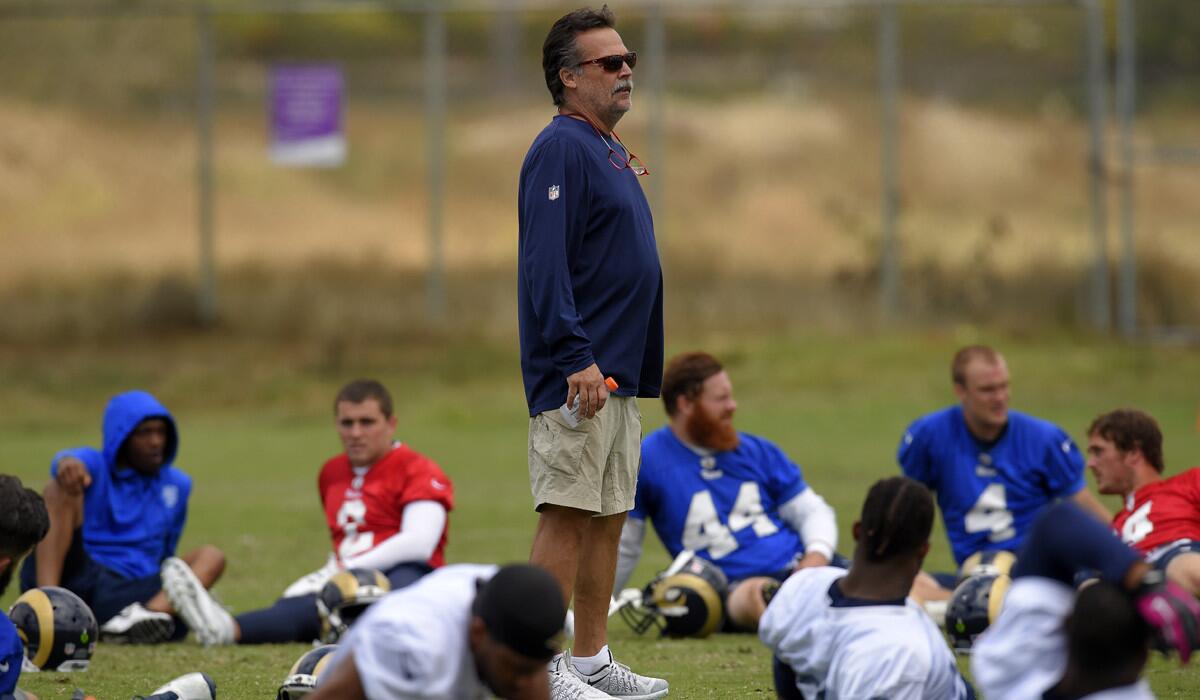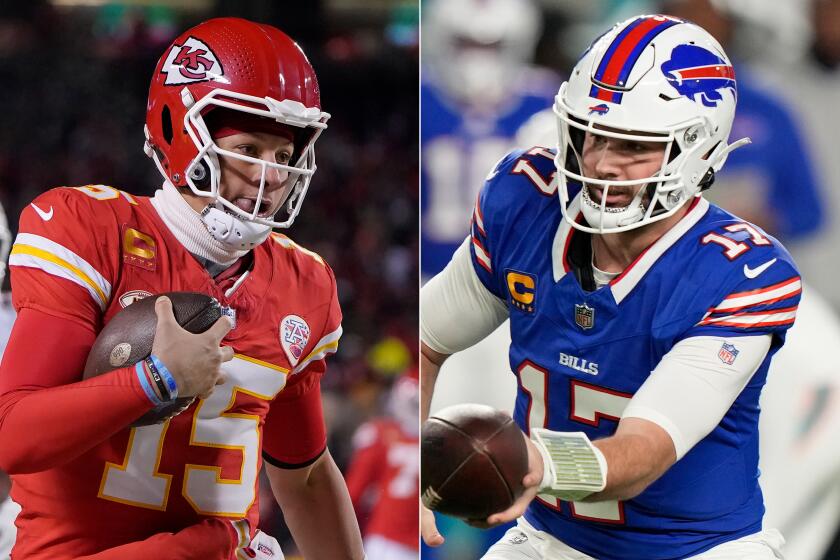Not your normal (NFL training) camp stories

Los Angeles Rams Coach Jeff Fisher stands among his players during practice in Oxnard on June 14.
- Share via
The NFL season is almost year-round now, with players staying in top shape throughout the spring and summer, heading into the ramp-up month of August.
That wasn’t always the case. Training camp was once a time for out-of-shape players to lose weight and gear up for the grind. Each team played six exhibition games, two more than they currently do, and every year was like starting from scratch.
“Back in those days, when you started training camp, you started with basics,” recalled former quarterback Archie Manning, who played 16 seasons, most of them with New Orleans. “You’d put in three running plays the first day, and three passes. The defense would put in one coverage.”
Current NFL players come into camp with a mental database of hundreds of variations of formations, plays and personnel packages.
“As an offense, we’d go out for the second week of practice, and there’s not but three coverages they could play against us,” Manning said. “So simple. Very vanilla. They were very slow to put in blitzes. Sometimes, you wouldn’t even put in blitzes until about the fourth preseason game.
“That used to be a real dilemma for quarterbacks, because you get to that third preseason game and you’re thinking, ‘Ooo, I wonder if I’m going to see any blitzes.’ Because we hadn’t really put in our protections or anything.”
For Manning, that brings to mind an exhibition game against Houston, and a pre-game conversation he had with Oilers strong safety Vernon Perry. Blitz-loving Jerry Glanville was Houston’s defensive coordinator at the time.
“I asked Vernon, ‘Y’all going to do any blitzing tonight?’” Manning said. “He kind of raised his eyebrows and said, ‘Well, maybe.’ So I said, ‘Let me tell you something. We don’t have any protection yet for blitzes. So if you blitz, I’m going to hit you right in the crotch. I want you to know that.’
“He kind of raised his eyebrows again, like, ‘Oh! OK.’”
Manning doesn’t remember Perry blitzing that game. Mission accomplished.
Other offbeat memories from NFL camps:
::
Boomtown
Marcus Allen unflinchingly ran through the heart of just about every NFL defense. He would plunge over a wall of defenders at the goal line without hesitation. When he got into a war of wills with Los Angeles Raiders owner Al Davis, Allen didn’t blink.
It wasn’t until he got to training camp with Kansas City that the star running back met his match — the extreme weather in River Falls, Wis., where the Chiefs staged their summer workouts.
“We had a thunder and lightning storm that had me begging for an earthquake,” recalled Allen, who grew up in San Diego. “It scared the daylights out of me. Living in California, we only had thunder and lightning maybe a handful of times. But when I got to the Midwest, the thunder shook the entire campus.
“If you weren’t used to that, it was pretty scary.”
::
Different kind of labor
Joe DeLamielleure had as distinguished an NFL career as just about any offensive lineman in the game. Fourteen seasons with the Buffalo Bills and Cleveland Browns, six Pro Bowls, six All-Pro designations, and finally a bust in the Pro Football Hall of Fame.
He didn’t have an ounce of prima donna in his 6-foot-3, 354-pound body. “Joe D” was Joe Lunch Pail, evidenced by the fact he went seven years playing every offensive snap of every exhibition game, plus the regular season.
All that pounding took a toll.
Forty-three years ago, when the Bills were at training camp, DeLamielleure requested a rare day off, because his wife, Gerri, was going into labor with their daughter. Coach Lou Saban excused him from practice, and the DeLamielleures drove to the hospital.
“I looked pretty bad from camp,” Joe said. “I had a black eye, holes in my forehead, and I had pulled a calf muscle so I was limping.”
In light of that, it’s no wonder what happened next.
“My wife was about to have a baby,” he said. “But when we got to the hospital, they thought she was checking me in.”
::
Ghost story
Before training camp to their indoor stadium, the Cardinals used to stage it at Northern Arizona University in Flagstaff. The players stayed in the dormitories.
One of those dorm rooms was haunted — or so the veterans would say — and the walls in that room were rumored to sweat blood. Whatever was actually happening, something strange was occurring.
“It looked like blood would seep through the paint,” said Ed Cunningham, a former Cardinals center. “Every year, a rookie would be assigned to that room, and I remember this one year that rookie was freaking out. He got to breakfast and he was kind of panting, `Is it true?’”
Well … maybe.
“Our medical staff had been around forever, the trainers and those guys,” Cunningham said. “I would not be surprised if they were doing it, because they were kind of in charge of making sure the place was safe. I think it might have been an equipment guy who was doing it.”
::
Pack mentality
Some of the hardest-working people in the NFL are the folks behind the scenes who set up the equipment and temporary facilities at the start of training camp, then pack and transport them at the end.
Setting up is easier because there’s more time on the front end. When camp ends, teams need their equipment moved immediately back to headquarters so that there’s no interruption in the practice schedule.
Back in the 1990s, when the Raiders trained in Oxnard, complications arose after camp had ended and the moving vans had been packed: Al Davis wanted to work out, and the weights were in the front of one of the trucks.
Still, he called the shots. Workers unpacked the truck so Davis could pump some iron, then repacked it and got rolling when he was done.
Ah, the benefits of ownership.
Twitter: @LATimesfarmer
More to Read
Go beyond the scoreboard
Get the latest on L.A.'s teams in the daily Sports Report newsletter.
You may occasionally receive promotional content from the Los Angeles Times.





